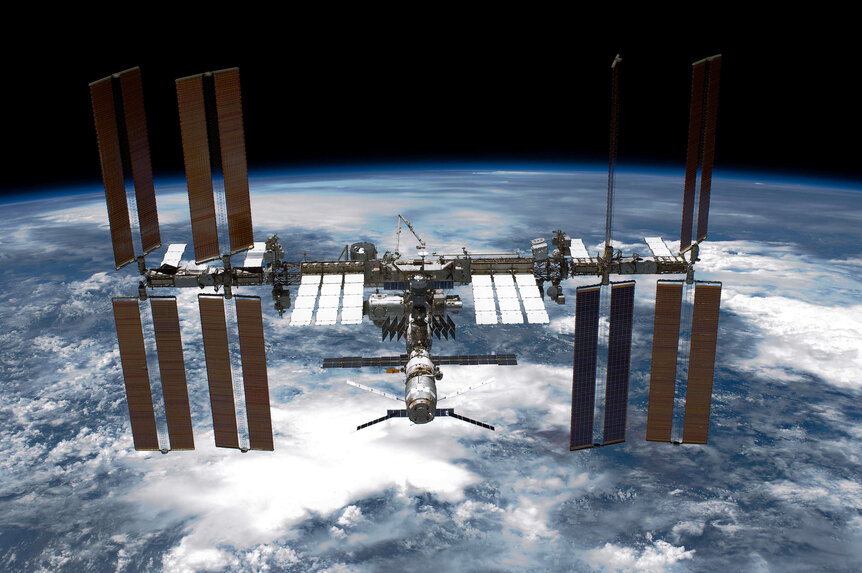Create a free profile to get unlimited access to exclusive videos, sweepstakes, and more!
The Life and Death (in 2031) of the International Space Station
The International Space Station's days are numbered, here's how it lived and how it will die.
One century from now, humanity’s impact on Earth’s climate has crossed a tipping point and is in rapid decline. A group of explorers, just a small fraction of the human population, boards a ship embarking on a one-way trip to another star. If the intrepid astronauts of The Ark (streaming now on Peacock) succeed in their mission, it will be the culmination of the most impressive space-based endeavor ever carried out. And it might just save our species.
Here in the real world, or rather in orbit around the real world, the International Space Station (ISS) is undoubtedly the most impressive spacecraft ever built by human hands. And soon it will suffer a violent cremation in the frictional fires of our own atmosphere.
The International Space Station Will Soon Fall to the Earth
The ISS was born back in 1998, November 20 to be exact, when Russia’s Roscosmos launched the Zarya module into orbit. A few weeks later on December 6, 1998, NASA launched the Unity module. Once connected, the two modules made up the beginning’s of what would become the largest spacecraft ever built, and it only happened because we dared to imagine what we could do if we worked across international borders.
RELATED: NASA Wants to Build a “Space Tug” to Safely Destroy the ISS
The ISS is a joint project between five space agencies – NASA, Roscosmos, JAXA (Japan), ESA (a collection of European nations), and CSA (Canada) – and participation aboard ISS is even wider ranging. While the nearly 300 astronauts who have been to the ISS are largely Russian or American, 21 nations are represented among their number.
Over the last 25 years, station operations have provided breakthroughs across a wide range of scientific disciplines including 3D printing in space, food growth in microgravity, and a better understanding of the wider cosmos through space-based astronomy. In the meantime, the station has offered a constant window onto our world from above, providing an orbital perspective of our planet which has immeasurable value.
How Large Is the International Space Station?
From small beginnings in 1998, the station has grown to include 16 modules, heat radiators, and massive solar arrays all connected by a sprawling truss system. Moreover, the station has been continuously inhabited by at least two people at any given time since November 2, 2000. For more than 23 years, there have always been at least two people (usually more) in space.
The total distance of the station spans 108 meters (357 feet) just short of the length of an American football field. All of that orbiting metal has a mass equivalent to about a million pounds, that’s about the same amount of stuff as 10 adult sperm whales. Douglas Adams, eat your heart out. In terms of internal space, the station is roughly the same size as a six-bedroom house. Of course, we typically measure houses in terms of square feet, but that doesn’t necessarily translate to an environment without gravity.
On the space station, every surface can serve as a floor, walls, or ceiling. In terms of the human experience, it might still feel like being cramped in a medium-sized building with a few of your coworkers, but you can get a little more usage out of the footage than you could on the ground.
How Does the International Space Station Get Air?
Building and launching a modular space station was a great first step, but it needed to be stocked with essentials before anyone could live there. That meant sending up all of the food, water, and supplies astronauts would need to live and work in orbit. It also meant filling the whole thing with breathable air and maintaining that atmosphere throughout the station’s lifetime.
On Earth, we don’t think much at all about where our next breath is going to come from. On the list of survival essentials, air is the most immediately important but also the most immediately available. In space, that’s obviously not the case.
Breathing aboard the ISS is a two-fold problem. The first issue is, of course, getting enough oxygen at the right pressure and concentration to facilitate oxygen exchange in the human body. The second issue is getting rid of carbon dioxide (CO2). Believe it or not, your body can’t actually detect the presence or absence of oxygen. It can’t know if it’s getting enough, and why should it? We evolved to live on the surface of our world and the presence of oxygen is a given. What your body really needs to know, and what it has built mechanisms for detecting, is the buildup of CO2 in your blood.
You can have all of the oxygen in the world at your disposal but it’s worthless if you can’t get rid of the CO2 that you exhale with each breath. The ISS uses a number of systems and processes to manage the air aboard the station and relies on regular resupplies from the surface. The initial oxygen in the system had to be provided from Earth in bulk, but once they filled the station, they worked hard to keep as much air in the system as possible.
RELATED: Astronauts Aboard the ISS Can Breathe Easy Now That NASA Has Launched an Upgraded CO2 Eliminator
Air management systems on the ISS suck up CO2 and remove it from the air through the magic of chemistry. CO2, when in the presence of lithium hydroxide, produces lithium carbonate and water. That chemical reaction gets rid of the CO2 in the air while providing more of another vital supply.
Meanwhile, the Oxygen Generation Assembly (OGA) takes in water from the Water Processor Assembly, excites it with electricity, and splits it into oxygen and hydrogen. The oxygen gets released back into the station while the hydrogen is either vented into space or sent to another system where it mixes with CO2 to create more water. These systems have kept the station in good working order for a quarter-century and will continue to support the astronauts and cosmonauts living there until it comes down.
When Is the International Space Station Crash Date?
In 2031, the ISS will come down for good in a fiery reentry over the Pacific Ocean. The precise date hasn’t been determined and likely won’t be for some time. Landing a spacecraft, especially a destructive landing, has to be planned with precision to mitigate the risk to the 8 billion people and counting who live on the ground.
What we do know is that operations aboard the ISS will wrap up at the end of the 2030 calendar year and it will come down shortly thereafter, likely in January of 2031. The death of the ISS is a sad thing, but inevitable. In the extreme environment of low-Earth orbit, the station cycles through day and night constantly, circling the planet every 90 minutes. The thermal stress of those constant temperature shifts slowly chip away at the station, and it’s not the only thing.
RELATED: International Space Station Destined for Point Nemo, the World's Spaceship Graveyard
Even in microgravity, loading strain on the station takes a toll over time. Every time a ship docks or undocks, the strain on the station shifts and its components can’t survive forever. Like a paperclip bent back and forth, they will eventually weaken and break. The ISS isn’t in any danger of breaking up in the near future, but it is aging, and the idea is to get out while the getting is good.
NASA has considered disassembling the station and returning it to Earth. Certainly, it is an important human artifact which we would like to preserve, but the logistics involved are overwhelming. Assembly of the station took 27 flights of the space shuttle, a reusable space vehicle we no longer have. Moreover, many of the components weren’t designed to be disassembled. It just wasn’t a part of the plan.
Instead, the station will be brought down in a controlled deorbit, dumping its shattered pieces into a narrow corridor over the Pacific known as the spaceship graveyard. It is sure to be an impressive spectacle when it happens, a glowing fireworks show fit for the best space station we could have hoped for.
The crew of The Ark (streaming now on Peacock) can only wish for a spaceship that good.






































